Underground seminar on foundations of quantum theory
(a.k.a. Underground Quantum Fight Club)
organised & supervised by Ryszard Kostecki
last update: 2.3.2023, 22:30
Some papers that resulted from the Seminar:
John DeBrota – 29.9.2016 – A quantum information geometric approach to renormalization
Morten Ib Munk-Nielsen – 19.6.2015 – Quantum measurements from entropic projections
Daniel Ranard – 31.5.2015 – An introduction to rigorous approaches to quantum field theory
Jeffrey Epstein – 3.3.2014 – Geometrisations of statistical models
The name 'Underground seminar' originated from the location of the room (in the underground of Physics Dept. of Univ. of Warsaw) where the second edition of the seminar was carried, as well as an implicit reference to Dostoevskiĭ’s Notes from Underground. The effective vibe of the seminar has been inspired by the Schulman–Weir Dead Poets Society.
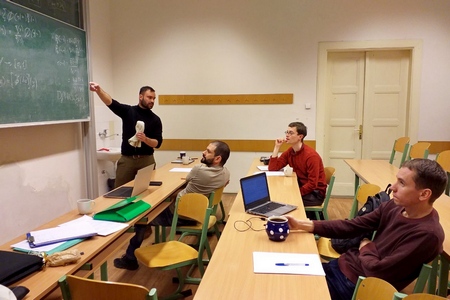
Edition 7: Winter 2023: Inference, geometry, and space-time
Participants: Jan Głowacki, Hamed Mohammady, Alexander Thomas, Václav Zatloukal
Local organisation: Václav Zatloukal
Locus: 23–31.1.2023, Room 114 (or 10), Fakulta jaderná a fyzikálně inženýrská ČVUT, Břehová 3, Praha
- (23.1.2023). Fluctuation theorem from retrodiction with a prior I – Hamed
- Watanabe S., 1955, Symmetry of physical laws. Part III. Prediction and retrodiction, Rev. Mod. Phys. 27, 179–186
- Petz D., 1988, Sufficiency of channels over von Neumann algebras, Quart J. Math. Oxford 39, 97–108
- Jarzynski C., 1997, Nonequilibrium equality for free energy differences, Phys. Rev. Lett. 78, 2690–2693
- Crooks G.E., 1998, Nonequilibrium measurements of free energy differences for microscopically reversible markovian systems, J. Stat. Phys. 90, 1481–1487
- Buscemi F., Scarani V., 2021, Fluctuation theorems from Bayesian retrodiction, Phys. Rev. E 103:052111, arXiv:2009.02849
- Aw C.C.X, Buscemi F., Scarani V., 2021, Fluctuation theorems with retrodiction rather than reverse processes, AVS Quant. Sci. 3:045601, arXiv:2106.08589
- Parzygnat A.J., Buscemi F., 2022, Axioms for retrodiction: achieving time-reversal symmetry with a prior, arXiv:2210.13531
- (24.1.2023). Fluctuation theorem from retrodiction with a prior II – Hamed
- (25.1.2023). Hessian and Weyl geometries – Alex
- Weyl H.K.H., 1918, Gravitation und Elektrizität, Sitzungsber. Königl. Preuss. Akad. Wissensch. 26, 465–480
- Weyl H.K.H., 1918, Reine Infinitesimalgeometrie, Math. Z. 2, 384–411
- Folland G.B., 1970, Weyl manifolds, J. Diff. Geom. 4, 145–153
- Shima H., 1976, On certain locally flat homogeneous manifolds of solvable Lie groups, Osaka J. Math. 13, 213–229
- Bokan N., Gilkey P.B., Simon U. - 1996 - Asymptotic spectra for Weyl geometries, Analele ştiinţifice ale Universităţii “Al. I. Cuza” din Iaşi, Matematică 42, Supliment, 84–90
- Shima H., 2007, The geometry of hessian structures, World Scientific, Singapore
- (26.1.2023). Bisognano–Wichmann theorem and Fulling–Unruh effect – Jan
- Fulling S.A., 1973, Nonuniqueness of canonical quantization in riemannian space-time, Phys. Rev. D 7, 2850–2862
- Unruh W.G., 1976, Notes on black-hole evaporation, Phys. Rev. D 14, 870–892
- Bisognano J.J., Wichmann E.H., 1976, On the duality condition for quantum fields, J. Math. Phys. 17, 303–321
- Sewell G.L., 1982, Quantum fields on manifolds: PCT and gravitationally induced thermal states, Ann. Phys. 141, 201–224
- Verch R., 2006, Vacuum fluctuations, geometric modular action and relativistic quantum information theory, in: Ehlers J., Lämmerzahl C. (eds.), Special relativity: will it survive the next 101 years?, Springer, Berlin, pp.133–162. arXiv:gr-qc/0512053
- (30.1.2023). Bisognano–Wichmann theorem and Fulling–Unruh effect II – Václav & Ryszard
- (31.1.2023). Prelogomena to Jacobson's thermodynamics of space-time – Václav & Ryszard
- Jacobson T., 1995, Thermodynamics of spacetime: the Einstein equation of state, Phys. Rev. Lett. 75, 1260–1263. arXiv:gr-qc/9504004
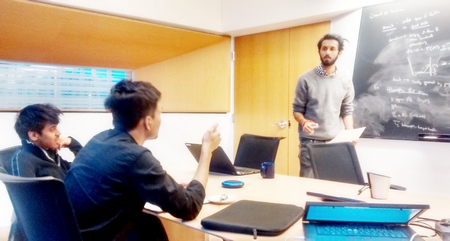
Edition 6: Spring 2018: Foundations of predictive QFTs
Participants: Nafiz Ishtiaque, Raeez Lorgat, Surya Raghavendran, Yehao Zhou
Locus: Fridays, 4:15-6:45p.m., Gravity Room, Perimeter Institute for Theoretical Physics, 31 Caroline St N, Waterloo ON
- (11.12.2017). Converging the views
- (16.2.2018). An intro to the Batalin–Vilkovisky formalism – Surya
- (23.2.2018). Operator product expansions in various QFT models – Nafiz/Surya/Vasu
- (9.3.2018). Batalin–Vilkovisky formalism, pt.2 – Surya
- Gwilliam O., Williams B. – 2017 – The holomorphic bosonic string
- (16.3.2018). Ring localisation and quasi-coherent sheaves – Raeez
- (30.3.2018). Batalin–Vilkovisky formalism, pt.3 – Surya
- (6.4.2018). Batalin–Vilkovisky formalism, pt.4 – Surya
Edition 5: Fall 2014/Spring 2015: Into the landscape of foundational quandaries
Participants: Ben Burdick, John DeBrota, Dylan Butson, Illan Halpern, Morten Munk-Nielsen, Thomas O'Brien, Daniel Ranard
Locus: Mondays 5-7pm, Gravity Room, Perimeter Institute for Theoretical Physics, 31 Caroline St N, Waterloo ON
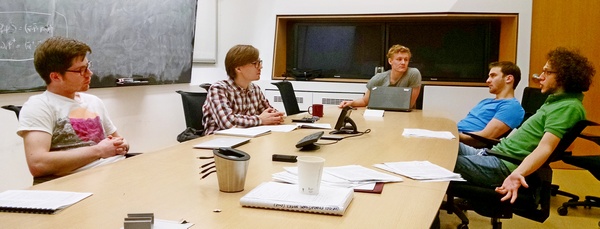
- (10.11.2014). Meeting #0
- (20.11.2014). Into the landscape, part I
stuff to read in advance: Edwin Jaynes - Information theory and statistical mechanics (1957). - (24.11.2014). Into the landscape, part II
stuff to read in advance: Bogdan Mielnik - Convex geometry: a travel to the limits of our knowledge (2012). - (08.12.2014). Into the landscape, part III
stuff to read in advance: Chris Fuchs - QBism, the perimeter of quantum bayesianism (2010). - (12.01.2015). Into the landscape, part IV
stuff to read in advance: Lluís Masanes, Markus Müller - Three-dimensionality of space and the quantum bit: an information-theoretic approach (2013). - (26.01.2015). Symmetric monoidal categories approach, part I - Illan Halpern & Daniel Ranard.
- (02.02.2015). Symmetric monoidal categories approach, part II - Illan Halpern & Daniel Ranard.
- (09.02.2015). Symmetric monoidal categories approach, part III - Illan Halpern & Daniel Ranard.
- (17.02.2015). C*-algebraic approach, part I - Dylan Butson & Tom O'Brien.
- (24.02.2015). C*-algebraic approach, part II - Dylan Butson & Tom O'Brien.
- (03.03.2015). C*-algebraic approach, part III - Dylan Butson & Tom O'Brien.
- (24.03.2015). Convex set/operational approach, part I - Ben Burdick & Morten Munk-Nielsen.
- (31.03.2015). Convex set/operational approach, part II - Ben Burdick & Morten Munk-Nielsen.
- (??.04.2015). Convex set/operational approach, part III - Ben Burdick & Morten Munk-Nielsen.
- (??.04.2015). Quantum information geometric approach, part I: Classical information geometry - John DeBrota.
- (14.04.2015). Quantum information geometric approach, part II: Kaehler geometry and Poisson flows of density matrices - Dylan Butson.
- (21.04.2015). Quantum information geometric approach, part III: Nonlinear information kinematics and dynamics - Ryszard Kostecki.
- (12.06.2015). Into the landscape, part V (coda)
stuff to read in advance: Ted Jacobson - Thermodynamics of spacetime: the Einstein equation of state (1995).
Edition 4: Spring 2014: Beyond von Neumann's foundations of quantum mechanics
Participants: Aysha Abdel-Aziz, Emily Adlam, Dylan Butson, Jeffrey Epstein, Max Klambauer, Nicco Pomata, Jason Wien
Locus: Mondays, 6:15-8:30 p.m., Sky room, Perimeter Institute for Theoretical Physics, 31 Caroline St N, Waterloo ON
- (03.02.2014). Differential and symplectic geometry of pure quantum states I - Nicco Pomata
- (10.02.2014). Differential and symplectic geometry of pure quantum states II - Nicco Pomata
Topics: Symplectic and riemannian geometry of projective quantum space, plus geometric phases as holonomies. How the specific conceptual and structural components of the Hilbert space based formalism for QM are reformulated in this setting? Linearity vs nonlinearity. Infinite dimensions? Kaehler manifolds beyond CPn?
- (17.02.2014). Symplectic geometry of density matrices and nonlinear observables I - Dylan Butson
- (24.02.2014). Symplectic geometry of density matrices and nonlinear observables II - Dylan Butson
Topics: Adjoint actions. Poisson manifolds of quantum states. Nonlinear generalisations of unitary evolution as hamiltonian flows. Nonlinear observables and their properties. Examples.
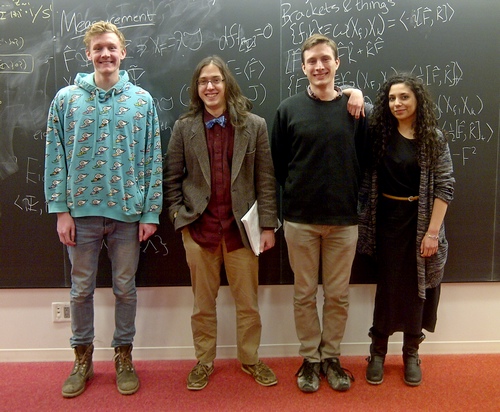
- (24.02.2014). Entropy and riemannian geometry of probability densities I - Jeffrey Epstein
- (03.03.2014). Entropy and riemannian geometry of probability densities II - Jeffrey Epstein
Topics: Probabilistic models and manifolds. Examples. Relative entropy functionals. Probabilistic riemannian metrics and affine connections. Norden--Sen and Chencov--Amari geometries. Markovian monotonicity. Chencov theorem. Eguchi equations. Dually flat probabilistic manifolds. Geometry of normal, exponential, and transformation models. Geometrisation of classical statistical mechanics.
- (24/31.03.2014). Unitarily inequivalent representations, C*-algebraic approach, and noncommutative integration I - Max Klambauer
- (31/07.04.2014). Unitarily inequivalent representations, C*-algebraic approach, and noncommutative integration II - Max Klambauer
Topics: The problem of unitary inequivalence on examples. Haag's theorem and its implication for description of interaction in QFT, and for particle interpretation. Borchers' class of quantum fields. Basic mathematical structure of C*- and W*-algebras. Noncommutative integration theory. Gel'fand--Naimark--Segal construction. KMS states and postulates of AQFT. How much (and why?) these approaches were (un)able to achieve when it comes to the description of predictive quantum dynamics.
- (14.04.2014). Logico-algebraic approaches to quantum foundations and quantum measure theory I - Jason Wien
- (21.04.2014). Logico-algebraic approaches to quantum foundations and quantum measure theory II - Jason Wien
Topics: Syntactic approaches: Birkhoff--von Neumann approach, framework based on posets (Mackey) vs lattices (Piron); semantic approach: partial boolean algebras (Kochen--Specker). Gleason theorem. Quantum measure theory. Quarrels with reconstruction theorems. Problems with tensor products, sequential measurements, and with interpretation.
Edition 3: Spring 2012: Non-orthodox approaches to quantum field theory
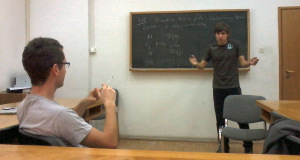
Participants: Paweł Duch, Mateusz Iskrzyński, Marcin Kotowski, Michał Kotowski, Jan Liszka-Dalecki
Locus: Mondays, 9:15-11:15 a.m., Department of Physics, University of Warsaw, Warszawa, Hoża 69, room N21
- (20.02.2012). Three different approaches to QFT: a background of Schwinger's approach - Paweł Duch
- (27.02.2012). Schwinger's source theory - part I - Paweł Duch
- (05.03.2012). Schwinger's source theory - part II - Paweł Duch
- (12.03.2012). Schwinger's action principle - Mateusz Iskrzyński
- (26.03.2012). Dittrich's analysis of Schwinger's approach - Paweł Duch
- (07.05.2012). Brunetti--Fredenhagen--Verch approach - part I - Jan Liszka-Dalecki
- (14.05.2012). Brunetti--Fredenhagen--Verch approach - part II - Jan Liszka-Dalecki
- (21.05.2012). Brunetti--Fredenhagen--Verch approach - part III - Jan Liszka-Dalecki
Edition 2: Spring 2011: Foundational issues in quantum theory
Participants: Paweł Duch, Bogusia Gorczyca, Mateusz Iskrzyński, Marcin Kotowski, Michał Kotowski, Jędrek Świeżewski
Locus: Room N21, Department of Physics, University of Warsaw, Warszawa, Hoża 69
- (17.02.2011). Sketch of the programme - Ryszard Kostecki
main text:- Ryszard Kostecki, 2011, Esquisse d'un programme (typed text with references will be available later)
- (24.02.2011). Elements of mathematical formalism of Hilbert space quantum mechanics & Algebraic approach to quantum theory I - Ryszard Kostecki
main texts:- Miklos Redei, Stephen Summers, 2007, Quantum probability theory
- Klaas Landsman, 2009, Algebraic quantum mechanics
(take a look on introductions, and your favorite topics of interest)- Rudolf Haag, 1996, Local quantum physics (see especially II.3, II.4 and III.1 for fundamental motivation of an algebraic approach exposed in mathematical detail but with particle theory oriented "physical" flavour; alternatively see V.1.1-V.1.3 for motivation comming from quantum equilibrium statistical mechanics)
- Bert Schroer, 1998, A course on modular localization and nonperturbative local quantum physics (here these topics are treated more extensively and with more applications)
- Gerard Emch, 1972, Algebraic methods in statistical mechanics and quantum field theory (first and still very good book about algebraic approach)
- Hans Halvorson, 2006, Algebraic quantum field theory (a detailed review of the mathematics of algebraic approach with the extensive discussion of the algebraic analysis of superselection)
- Miklos Redei, 1998, Quantum logic in algebraic approach (algebraic perspective on quantum logic issues; also very good book)
- (03.03.2011). Haag's theorem and the failure of particle and field interpretations - Mateusz Iskrzyński
main texts:- John Earman, Doreen Fraser, 2006, Haag's theorem and its implications for the foundations of QFT
- Doreen Fraser, 2008, The fate of ‘particles’ in quantum field theories with interactions
- Stephen Summers, 1998, On the Stone-von Neumann uniqueness theorem and its ramifications
- Frederick Kronz, Tracy Lupher, 2005, Unitarily inequivalent representations in algebraic quantum theory
- David Baker, 2008, Against field interpretations of quantum field theory
- Rob Clifton, Hans Halvorson, 2000, Are Rindler quanta real? Inequivalent particle concepts in quantum field theory
- Jonathan Bain, 2000, Who is afraid of Haag's theorem?
- Doreen Fraser, 2009, Quantum field theory - underdetermination, inconsistency, and idealization
- Tracy Lupher, 2005, Who proved Haag’s theorem?
- Gerard Emch, 1972, Algebraic methods in statistical mechanics and quantum field theory, pp.247-253
- Rudolf Haag, 1955, On quantum field theories
- (17.03.2011). Haag theorem, etc. II - Mateusz Iskrzyński
- (24.03.2011). POVM's and the failure of usual notion of observable - Paweł Duch
main texts:- Paul Busch, Pekka Lahti, 2008, Observable
- D.A. Dubin, M. A. Hennings, P. Lahti, J.-P. Pellonpää, 2002, A dilemma in representing observables in quantum mechanics
- W. M. de Muynck, W. De Baere, H. Martens, 1994, Interpretations of quantum mechanics, joint measurement of incompatible observables, and counterfactual definiteness
- Pekka Lahti, Juha-Pekka Pellonpää, Kari Ylinen, 2005, Two questions on quantum probability
- E.B. Davies, J.T. Lewis, 1970, An operational approach to quantum probability
- Teiko Heinosaari, Mario Ziman, 2008, Guide to mathematical concepts of quantum theory
- Roderich Tumulka, 2007, POVM
- E.B. Davies, 1976, Quantum theory of open systems
- (31.03.2011). Algebraic approach to quantum theory II - Ryszard Kostecki
main texts:- Ryszard Kostecki, 2011, An introduction to algebraic approach to quantum theory (draft)
- Rudolf Haag, 1996, Local quantum physics (sections II.5.5 and V.1-3)
- (07.04.2011). Path integrals: review of approaches and problems - Jędrek Świeżewski
main texts:- John Klauder, 2003, The Feynman path integral: an historical slice
- Pierre Cartier, Cecile DeWitt-Morette, 1995, A new perspective on functional integration
- Sergio Albeverio, Raphael Høegh-Krohn, Sonia Mazzucchi, 2008, Mathematical theory of Feynman path integrals (chapter 1 and section 10.4)
- R.J. Rivers, 1987, Path integral methods in quantum field theory (chapter 6)
- Hagen Kleinert, 2003, Path integrals in quantum mechanics, statistics, polymer physics, and financial markets
- M. Chaichian, A. Demichev, 2001, Path integrals in physics
- (21.04.2011). Renormalisation: review of approaches - Bogusia Gorczyca
main texts:- Tian Yu Cao, Silvan S. Schweber, 1993, The conceptual foundatons and the philosophical aspects of renormalization theory
- Bertrand Delamotte, 2003, A hint of renormalization
- John C. Collins, 1984, Renormalization - An introduction to renormalization, the renormalization group, and the operator-product expansion
- Giuseppe Benfatto, Giovanni Gallavotti, 1993, Renormalization group
- Michael Duetsch, 2010, Connection between the renormalization groups of Stückelberg-Petermann and Wilson
- Michael Duetsch, Klaus Fredenhagen, 2004, Perturbative renormalisation and BRST
- (05.05.2011). Renormalisation: Epstein--Glaser approach - Paweł Duch
main texts:- Günter Scharf, 1995, Finite quantum electrodynamics - the causal approach
- Gudrun Pinter, 2000, Epstein-Glaser Renormalization - Finite Renormalizations, the S-Matrix of phi4 Theory and the Action Principle
- H. Epstein, V. Glaser, 1973, The role of locality in perturbation theory
- Romeo Brunetti, Klaus Fredenhagen, 1997, Interacting quantum fields in curved space - renormalizability of phi4
- (19.05.2011). Renormalisation: Epstein--Glaser approach II - Paweł Duch
- (24.06.2011). Quantum theory and space-time from quantum information geometry - Ryszard Kostecki
Edition 1: Summer 2008: From germs and groupoids to quantum theory
Participants: Jan Gutt, Wojciech Kamiński, Jacek Kopeć
Locus: SFT Room, Department of Physics, University of Warsaw, Warszawa, Hoża 69
- (22.07.2008). Differential geometry and smooth analysis in toposes, part II - Ryszard Kostecki
- (22.07.2008). Germs of algebraic states in Haag-Ojima-Bostelmann approach, part III - Jacek Kopeć
- (21.07.2008). Germs of algebraic states in Haag-Ojima-Bostelmann approach, part II - Jacek Kopeć
- (21.07.2008). Differential geometry and smooth analysis in toposes, part I - Ryszard Kostecki
- (21.07.2008). Quantisation of groupoids a la Landsman, part II - Jan Gutt
- (21.07.2008). Germs of algebraic states in Haag-Ojima-Bostelmann approach, part I - Jacek Kopeć
- (20.07.2008). Quantisation of groupoids a la Landsman, part I - Jan Gutt